Bjarke Ingels Group Architects’ £34m Danish Maritime Museum has been built entirely underground - in a former dock in Elsinore. The challenge was building underneath the water level without Hamlet’s old castle sinking into oblivion
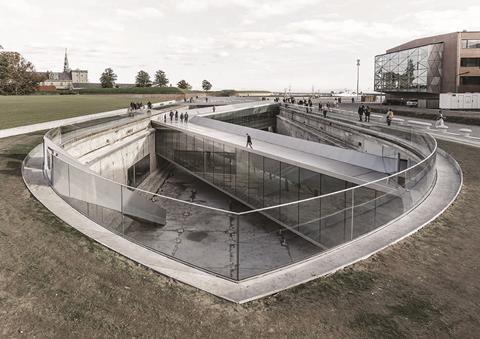
There can be few places more deeply entrenched in ancient folklore and legend than the northern Danish seaport of Helsingør. Known as Elsinore in English, the town is home to historic Kronborg castle which was the atmospheric setting for Shakespeare’s Hamlet. And in Arthurian legend King Arthur’s wicked half-sister lures a mythical Danish king away from the castle in her quest to recapture France.
Helsingør was also home to seminal Danish architect Jørn Utzon and he worked on a small housing development here before leaving for Australia in the late fifties to design the Sydney Opera House. But Helsingør has recently enjoyed a distinctly more contemporary and temporal slice of fame than its colourful heritage might suggest with the long-awaited reopening of the Danish Maritime Museum earlier this month.
The location of Bjarke Ingels Group Architects’ £34m competition-winning scheme is arguably its most intriguing draw; it has been built entirely underground. Some 7,600m² of accommodation has been constructed in and around a former dry dock in Helsingør harbour measuring 150m long, 25m wide and 9m deep.
The former dockyard in which the new museum has now been built is situated next to Kronborg castle itself, which ironically, was the old museum’s prestigious but patently impractical home. Built in fairytale Renaissance style in 1574, complete with polygonal turrets and melodramatic coastal setting, Kronborg is one of only three UNESCO World Heritage Sites in Denmark and is one of the most important cultural and historic sites in the country.
But the castle also imposed two key constraints on the new museum project. The main entrance route to Kronborg is used by over 800,000 visitors per year and it straddles right over the dock. So any new scheme had to preserve this access. And in order to maintain views towards the castle, the new museum structure was prohibited from extending beyond one metre above ground level and was therefore to be located predominantly underground.
The location of the museum is also significant for another important reason. When the competition for the museum was held in 2007, the brief also stated that the new building be constructed entirely within the confines of the existing concrete dock. Five renowned Danish practices entered the contest, including C.F. Møller and Schmidt Hammer Lassen. Every entrant complied with the rules of the brief and placed the museum within the dock, except one: BIG.
“It just didn’t feel right filling in the dock,” explains BIG associate partner and project architect David Zahle. “There were three main reasons why: the dock was too small and dark; achieving the required floorplate area would have destroyed the volume of the dock; and to properly insulate the museum, a new concrete wall would have to be built adjacent to the existing dock walls anyway. As we developed our concept, the main question we kept asking ourselves was ‘can we preserve the texture of the old dock?’ And the answer, as it turned out, was yes.”
Preserving the dock’s old texture required an imaginative, though controversial solution. BIG broke the competition rules and proposed an underground museum almost twice as large as that specified in the brief and built around the dock as well as within it. Despite ignoring these key aspects of the brief, their proposal won, understandably infuriating the losing entrants. Legal proceedings ensued, all of which have now been amicably settled.
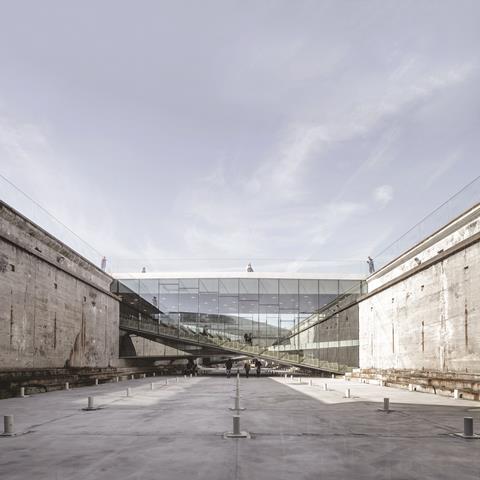
Draining the dock
However, BIG’s ambitious proposals also presented exacting technical challenges. Rather than using the existing dock walls as the boundary to the museum, BIG instead proposed building four new underground concrete walls around the dock in order to fully encase and insulate it and also provide additional accommodation around it. On plan, the dock now lies at a diagonal angle within this new rectilinear volume with the closest part of the original dock three metres away from the concrete wall and the furthest 20m away.
Implementing this configuration, however, meant dealing with one big problem: water. Dock 1, as the new museum site was formerly known, closed to industrial use in the late seventies and had been filled with water ever since. Moreover, the entire site was also underneath the water level.
Engineers initially proposed pumping the water out before construction began but it soon emerged that the pumping process alone would cost £4m and would expose Kronborg castle to the risk of subsidence or even worse, sinking. Therefore it was decided to build an underwater concrete plate underneath the dock. This would have enabled the water to be pumped out without compromising the stability of the earth around the dock.

But this too came with its problems. Some 1,500 anchors 20m deep were required to hold the 6,000m² plate in place and it also required 466 steel piles burrowed 40m into the ground. It was then discovered that the piling might be unstable as potentially corrosive fish sediment was located in the ground below the dock. When contractors proved reluctant to bid on the project due to its technical complexity and high risk, this proposal too was abandoned.
The third and final strategy was the one eventually built. Four giant slurry walls have been constructed around the dock; these now constitute the extent of the new rectangular volume within which the dock and new museum lie. These walls extend to just 600mm below ground level but are a prodigious 10m high and 4m wide. These were constructed over six months and once they were complete and had formed into a watertight, stabilising barrier between the dock and the damp earth around it, the dock water was finally pumped out.
Bridging the void
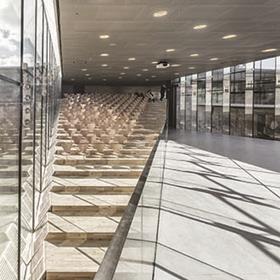
The old dock has now been reconfigured as an open, sunken and accessible plaza that forms the centrepiece of the new museum. Rather that the museum filling the dock, as the brief originally called for, it wraps around it and exposes the rough hewn concrete surfaces of the dock walls, with all their grooved imperfections and indentations, to public view for the first time. “Rather than concealing it, visitors are able to directly experience and immerse themselves in the dock,” explains Zahle with relish: “The dock itself becomes an exhibit and at 150m long, it must be one of the largest exhibits in the world.”
But of course the old dock has not been left entirely untouched. Large expanses of glazing have been cut at various locations into its thick walls which enable, despite its subterranean aspect, natural light to pour into the interior.
One aspect of this measure makes Zahle particularly proud. He explains: “Initially the museum considered housing its administrative offices in another building as Danish building regulations state that skylights are insufficient to light underground workspaces. But because of the way we opened up the dock and used it to admit light right into the museum, we were able to get it reclassified as an urban plaza.
“This meant that despite the fact they were underground, we were able to incorporate offices into the new design as they receive so much daylight through the windows facing onto the dock.”
But the biggest visual intervention in the dock is the trio of glass and steel bridges that zig-zag across it and hover over its floor. Sheer sheets of glazing hang underneath them, enclosing the few museum interiors that encroach into the dock boundary.
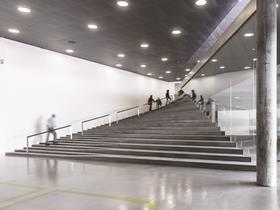
The first provides local access over the dock. The second forms the critical main entrance route to the neighbouring Kronborg castle. But the third and most significant bridge is a sprawling 70m long continuous ramp that descends into the dock before bending back on itself and reaching the museum entrance. This is located at the uppermost level of the museum directly underneath the environs of the dock. As Zahle points out, the bridge was essentially “bent to fit within the dock” as it would have been impossible to accommodate the achieved 1/50 gradient required to navigate a whole floor within the dock’s 25m width.
This gradual descent mirrors the internal configuration of the museum. The interior spaces have been conceived as a continuous ramp that circles around and through the dock. Inevitably, the most exhilarating spaces are those that provide direct views out into the dock through expansive sheets of glazing. The double height cafe that occupies one end of the dock and provides access to it, the internal ramped galleries that occupy the space underneath the main entrance ramp and most creatively, the skewered auditorium improbably folded into the underside of one of the secondary bridges.
Inside out
Unusually for a public building, the Danish Maritime Museum is an exercise in invisibility. The most obvious indicator of this is that the dock was left (almost) empty rather than filled. This defiance of the competition brief, while justly causing chagrin to those entrants who complied, was a brave and inspired decision that rightly prioritises the physical fabric of the dock and proves that briefs often require as much development as the proposals they solicit.
But there are other clues to this sense of invisibility too. The museum is obviously hidden underground. Eager to impress, few public buildings dare to invite the public to descend to their entrances rather than rise up to them. London’s Tate Modern is one of the few examples, as is, admittedly for practical as well as conceptual reasons, the Danish Maritime Museum. It is a brave architectural gesture that resonates with modesty and deference.
Zahle also speaks of the museum “turning the dock inside out”, a phrase which perfectly captures the inverted spatial aspect of the reconfigured dock where bridges and views protrude like insolent, exposed intestines across the empty space. Ironically, it is these very incursions that emphasise the raw physicality of the original dock fabric.
For despite all the shifting geometries and distorted perspectives that characterise the sloping underworld that has been carved into the dock, the subtle interplay between solid and void and the searing transparency created by the clever manipulation of glass and light all rightly ensure that it is the dock itself that always remains the star exhibit.
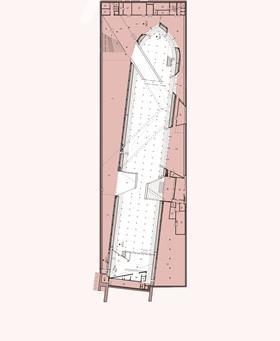
It is tempting to draw comparisons between Denmark’s new maritime museum and our own recently redeveloped version at Greenwich. Both our countries are great seafaring nations. Both museums were designed by Danish architects, with C.F. Møller providing the concept design for Greenwich. And both museums, located in the shadow of UNESCO World Heritage Sites, attempt to deploy assuredly contemporary architecture to subtly and sensitively engage with the weight of history that surrounds them.
But there is one key difference. While Greenwich, perhaps inevitably, is a polite and passive spectator of the heritage it is ensconced within, Denmark’s equivalent violently engages with it, deferring to the castle yes, but nonetheless cutting and slicing its way through the dock in a relentless bid to force recognition of the old by antagonising it with the intervention of the new.
It is a fitting testament to nuanced combination of force and humility that characterises the new museum’s architecture that the empty, subterranean void at the heart of this scheme remains the most powerful intervention of all.
Project team
Client The Danish Mercantile and Maritime Museum / Municipality of Helsingør
Architects Bjarke Ingels Group Architects (BIG)
Main contractor Maritime Museums Byg ApS
Engineer Ramboll A/S
Exhibition design Kossmann.dejong.



























No comments yet